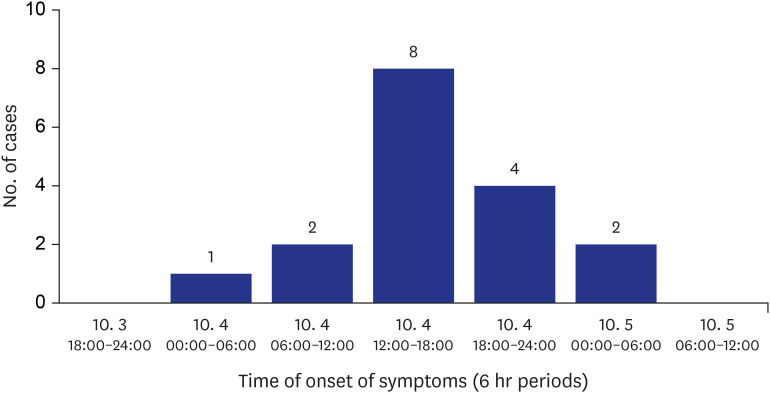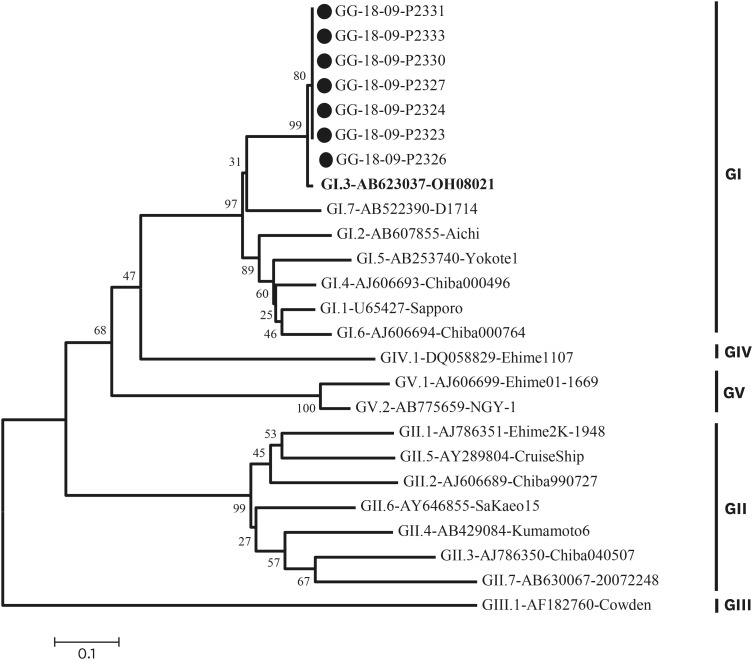J Korean Med Sci.
2020 Aug;35(34):e281. 10.3346/jkms.2020.35.e281.
An Outbreak Associated with Sapovirus GI.3 in an Elementary School in Gyeonggi-do, Korea
- Affiliations
-
- 1Division of Viral Diseases, Center for Laboratory Control of Infectious Diseases, Korea Centers for Disease Control and Prevention, Osong, Korea
- 2Division of Infectious Disease Research, Gyeonggi-do Institute of Health and Environment, Suwon, Korea
- 3Bundang-gu Health Center Infectious Disease Response Team, Seongnam, Korea
- KMID: 2505721
- DOI: http://doi.org/10.3346/jkms.2020.35.e281
Abstract
- On October 4, 2018, an outbreak of gastroenteritis associated with sapovirus occurred among elementary school students in Gyeonggi-do, Korea. Epidemiologic studies were conducted in a retrospective cohort approach. Using self-administered questionnaires, we collected information on symptoms and food items consumed. Of the 999 subjects, 17 developed patients that met the case definition. The main symptom was vomiting (100%), and the symptomatic age was 6-12 years. Positive samples were identified by conventional reverse transcription polymerase chain reaction for sequencing. They were classified into genotype GI.3 by phylogenetic analysis. This is the first report of an outbreak associated with sapovirus GI.3 in Korea.
Keyword
Figure
Reference
-
1. Hansman GS, Oka T, Katayama K, Takeda N. Human sapoviruses: genetic diversity, recombination, and classification. Rev Med Virol. 2007; 17(2):133–141. PMID: 17340567.
Article2. Oka T, Wang Q, Katayama K, Saif LJ. Comprehensive review of human sapoviruses. Clin Microbiol Rev. 2015; 28(1):32–53. PMID: 25567221.
Article3. Hall AJ, Lopman BA, Payne DC, Patel MM, Gastañaduy PA, Vinjé J, et al. Norovirus disease in the United States. Emerg Infect Dis. 2013; 19(8):1198–1205. PMID: 23876403.
Article4. Nakata S, Honma S, Numata KK, Kogawa K, Ukae S, Morita Y, et al. Members of the family caliciviridae (Norwalk virus and Sapporo virus) are the most prevalent cause of gastroenteritis outbreaks among infants in Japan. J Infect Dis. 2000; 181(6):2029–2032. PMID: 10837186.
Article5. Hansman GS, Saito H, Shibata C, Ishizuka S, Oseto M, Oka T, et al. Outbreak of gastroenteritis due to sapovirus. J Clin Microbiol. 2007; 45(4):1347–1349. PMID: 17267629.
Article6. Phan TG, Trinh QD, Yagyu F, Okitsu S, Ushijima H. Emergence of rare sapovirus genotype among infants and children with acute gastroenteritis in Japan. Eur J Clin Microbiol Infect Dis. 2007; 26(1):21–27. PMID: 17200841.
Article7. Usuku S, Kumazaki M, Kitamura K, Tochikubo O, Noguchi Y. An outbreak of food-borne gastroenteritis due to sapovirus among junior high school students. Jpn J Infect Dis. 2008; 61(6):438–441. PMID: 19050349.8. Johansson PJ, Bergentoft K, Larsson PA, Magnusson G, Widell A, Thorhagen M, et al. A nosocomial sapovirus-associated outbreak of gastroenteritis in adults. Scand J Infect Dis. 2005; 37(3):200–204. PMID: 15849053.9. Kirby AE, Streby A, Moe CL. Vomiting as a symptom and transmission risk in norovirus illness: evidence from human challenge studies. PLoS One. 2016; 11(4):e0143759. PMID: 27116105.
Article10. Gallimore CI, Iturriza-Gomara M, Lewis D, Cubitt D, Cotterill H, Gray JJ. Characterization of sapoviruses collected in the United Kingdom from 1989 to 2004. J Med Virol. 2006; 78(5):673–682. PMID: 16555276.
Article
- Full Text Links
- Actions
-
Cited
- CITED
-
- Close
- Share
- Similar articles
-
- Human Norovirus Genogroups Detected from Acute Gastroenteritis Patients in Seoul from May 2013 to April 2015
- Evaluation of a New Multiplex Real-Time PCR Assay for Detecting Gastroenteritis-Causing Viruses in Stool Samples
- Elementary, Middle, and High School Health Teachers' Countermeasures Against an Outbreak of Pandemic Diseases, Including MERS
- Epidemiological Study of Ground-waterborne Norovirus GI.3-associated Gastroenteritis Outbreaks in Gyeonggi Province of South Korea in May 2011
- Epidemiologic Study of Measles Outbreak in School-Aged Children in East KyongGi-Do Area



